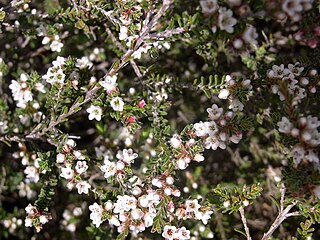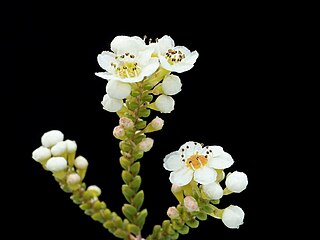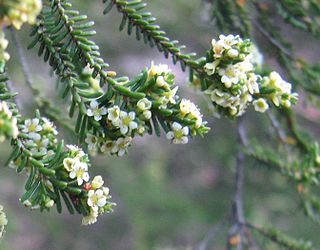
Micromyrtus blakelyi is a species of flowering plant in the family Myrtaceae and is endemic to a small area near Sydney Australia. It is a low, cushion-like shrub with overlapping, keeled, linear leaves and small pink flowers arranged singly in upper leaf axils.

Micromyrtus ciliata is a species of flowering plant in the family Myrtaceae and is endemic to south-eastern continental Australia. It is a spreading to erect shrub with crowded, oblong to egg-shaped leaves and small white or pink flowers arranged singly in upper leaf axils, forming clusters on the ends of branches.
Micromyrtus acuta is a species of flowering plant in the myrtle family, Myrtaceae and is endemic to the southwest of Western Australia. It is an erect shrub with small, oblong leaves and small white flowers in the upper leaf axils.
Micromyrtus arenicola is a species of flowering plant in the myrtle family, Myrtaceae and is endemic to a small area in the southwest of Western Australia. It is an erect shrub with small, linear to narrowly egg-shaped leaves and small white flowers.
Micromyrtus barbata is a species of flowering plant in the family Myrtaceae and is endemic to inland areas of Western Australia. It is a shrub with small, overlapping, narrowly egg-shaped leaves and small white flowers arranged singly in upper leaf axils.
Micromyrtus chrysodema is a species of flowering plant in the myrtle family, Myrtaceae and is endemic to a small area of inland Western Australia. It is a densely branched shrub with small, narrowly oblong leaves and small white flowers.
Micromyrtus collina is a species of flowering plant in the myrtle family, Myrtaceae and is endemic to a small area in the southwest of Western Australia. It is an erect shrub with small, linear to narrowly egg-shaped leaves and small white flowers that turn pink as they age.
Micromyrtus fimbrisepala is a species of flowering plant in the family Myrtaceae and is endemic to inland Australia. It is a shrub with overlapping, broadly elliptic to more or less round leaves and small pink flowers arranged singly in upper leaf axils.
Micromyrtus greeniana is a species of flowering plant in the myrtle family, Myrtaceae and is endemic to a small area in the west of Western Australia. It is a spindly shrub with linear to egg-shaped leaves and small white or cream-coloured flowers.
Micromyrtus helmsii is a species of flowering plant in the myrtle family, Myrtaceae and is endemic to inland areas of Australia. It is a slender, erect or spreading shrub with overlapping, decussate, oblong leaves, and flowers with about 7 stamens, arranged singly in leaf axils.
Micromyrtus hymenonema is a species of flowering plant in the myrtle family, Myrtaceae and is endemic to inland areas of Western Australia. It is a shrub with overlapping, decussate linear leaves and pink flowers arranged singly in leaf axils with about 10 stamens in each flower.
Micromyrtus imbricata is a species of the family Myrtaceae and is endemic to the south of Western Australia. It is a slender, erect shrub with broadly egg-shaped leaves, white, pink or red-tinged flowers 4–5 mm (0.16–0.20 in) in diameter, and 10 stamens.

Micromyrtus monotaxis species of the family Myrtaceae and is endemic to the Western Australia. It is an erect shrub with egg-shaped leaves with the narrower end toward the base, white flowers 4.5–6.0 mm (0.18–0.24 in) in diameter, and 10 stamens.
Micromyrtus navicularis is a species of flowering plant in the myrtle family, Myrtaceae and is endemic to a small area in the south of Western Australia. It is an erect shrub with narrowly egg-shaped leaves, and small white flowers in upper leaf axils with 10 stamens in each flower.
Micromyrtus papillosa is a species of flowering plant in the family Myrtaceae and is endemic to the south-west of Western Australia. It is sometimes an erect or low, otherwise spreading shrub with egg-shaped leaves with the narrower end towards the base, and white flowers with 5 stamens.
Babingtonia maleyae, commonly known as the Narrogin babingtonia, is a species of flowering plant in the family Myrtaceae and is endemic to the southwest of Western Australia. It is a compact shrub with narrowly egg-shaped to elliptic leaves and white flowers usually arranged singly in leaf axils, each flower with 17 to 20 stamens.
Pimelea forrestiana is a species of flowering plant in the family Thymelaeaceae and is endemic to Western Australia. It is a shrub with linear to narrowly elliptic leaves arranged in opposite pairs, and head-like clusters of yellow, tube-shaped flowers.
Micromyrtus gracilis is a species of flowering plant in the myrtle family, Myrtaceae and is endemic to central Queensland. It is a slender shrub with overlapping, egg-shaped leaves and white flowers arranged singly in leaf axils with 5 stamens in each flower.

Micromyrtus hexamera is a species of flowering plant in the myrtle family, Myrtaceae and is endemic to eastern Australia. It is a shrub with many drooping branches, egg-shaped leaves with the narrower end towards the base, and white to pink flowers arranged singly in leaf axils with 12 stamens in each flower.

Micromyrtus hexamera is a species of flowering plant in the myrtle family, Myrtaceae and is endemic to Queensland. It is a shrub with erect or spreading branchlets, overlapping linear leaves, and white flowers arranged singly in leaf axils with 5 stamens in each flower.






